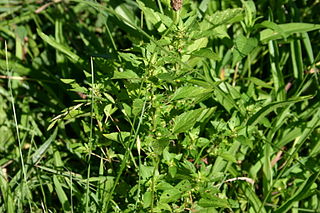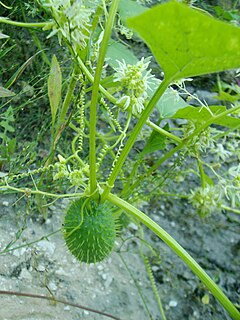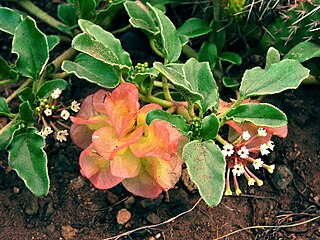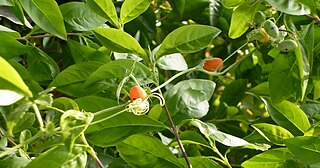
The Cucurbitaceae, also called cucurbits or the gourd family, are a plant family consisting of about 965 species in around 95 genera, of which the most important to humans are:

Smilax rotundifolia, also known as roundleaf greenbrier or common greenbrier, is a woody vine native to the southeastern and eastern United States and eastern Canada. It is a common and conspicuous part of the natural forest ecosystems in much of its native range. The leaves are glossy green, petioled, alternate, and circular to heart-shaped. They are generally 5–13 cm long. Common greenbrier climbs other plants using green tendrils growing out of the petioles.

Parthenocissus inserta, also known as thicket creeper, false Virginia creeper, woodbine, or grape woodbine, is a woody vine native to North America, in southeastern Canada and a large area of the United States, from Maine west to Montana and south to New Jersey and Missouri in the east, and Texas to Arizona in the west. It is present in California, but it may be an introduced species that far west. It is introduced in Europe.

Vicia sepium or bush vetch is a plant species of the genus Vicia. A nitrogen-fixing, perennial, leguminous climbing plant that grows in hedgerows, grasslands, the edges of woodland, roadsides and rough ground. It occurs in western Europe, Russia including Siberia, Crimea, Caucasus and Central Asia. It can also be found in eastern Canada, north-eastern states of the USA and, where suitable habitat occurs, in Greenland. It is also found throughout England and eastern parts of Wales.

Ipomoea pandurata, known as man of the earth, wild potato vine, manroot, wild sweet potato, and wild rhubarb, is a species of herbaceous perennial vine native to North America. It is a twining plant of woodland verges and rough places with heart-shaped leaves and funnel-shaped white flowers with a pinkish throat. The large tuberous roots can be roasted and eaten, or can be used to make a poultice or infusion. When uncooked, the roots have purgative properties.

Acalypha rhomboidea is a plant in the spurge family, Euphorbiaceae.

Dalibarda repens(dewdrop, false violet, star violet, Robin runaway. French Canadian: dalibarde rampante) is a perennial plant in the rose family, native to eastern and central Canada and to the northeastern and north-central United States. It is the only species in the genus Dalibarda, which is closely allied with the genus Rubus. The species is often included in the genus Rubus as Rubus repens (L.) Kuntze. It is fairly easily grown in shady locations in damp to wet, acidic soils, and is frequently used in wildflower and bog gardens as a ground-cover.

Echinocystis is a monotypic genus in the gourd family, Cucurbitaceae. The sole species is E. lobata, commonly called wild cucumber, prickly cucumber or bur cucumber. It is an annual, sprawling plant that is native to North America.

Bryonia alba is a vigorous vine in the family Cucurbitaceae, found in Europe and Northern Iran. It has a growth habit similar to kudzu, which gives it a highly destructive potential outside its native range as a noxious weed. Other common names include false mandrake, English mandrake, wild vine, and wild hops, wild nep, tamus, ladies' seal, and tetterbury.

Ranunculus recurvatus, the blisterwort or hooked crowfoot, is a plant species of the genus Ranunculus in the family Ranunculaceae native to eastern North America. It is an early-flowering plant of moist deciduous woods from central Quebec south to Florida.

Tripterocalyx micranthus is a species of flowering plant in the four o'clock family known by the common names smallflower sandverbena and small-flowered sand-verbena.
Sicyos albus is a species of flowering plant in the gourd family known by the common names anunu and white bur-cucumber. It is endemic to Hawaii, where it is known only from the island of Hawaii. It is threatened by the destruction and degradation of its habitat. It is a federally listed endangered species of the United States.

Sicyos macrophyllus is a rare species of flowering plant in the Cucurbitaceae, the squash family. It is endemic to Hawaii where it is present only on the island of Hawaii. It has likely been extirpated from the island of Maui. Common names include alpine bur cucumber, largeleaf bur-cucumber, and 'anunu.

Ranunculus cortusifolius, also known as the Azores buttercup or Canary buttercup, is a plant species in the genus Ranunculus, family Ranunculaceae, the buttercup or crowfoot family. It grows on moister sites throughout the Azores, Madeira and Canary Islands but is widely cultivated elsewhere as an ornamental. There are reports of it having become naturalized in parts of California.

Ctenolepis garcini, also known as Garcin's bur cucumber, is a tender climber of the family Cucurbitaceae. It is one of the three species of the genus Ctenolepis. It is widely distributed in southern India and Ceylon. The species was named after French botanist Laurent Garcin, who traveled India in the 18th century.
Marah gilensis, commonly known as the Gila manroot, is a species of flowering plant in the family Cucurbitaceae, endemic to Arizona and New Mexico in the United States.

Coccinia abyssinica is an Ethiopian species of Coccinia which was first described by Jean-Baptiste Lamarck. The tuber is under its Oromo name anchote a well-known local crop, but also the leaves are eaten.
Cucumis hystrix is a monoecious climbing vine in the family Cucurbitaceae. The specific epithet is New Latin for "porcupine".

Solena amplexicaulis, commonly known as the creeping cucumber, is a species of plant in the family Cucurbitaceae, native to tropical southern Asia. The fruits, leaves, roots and shoots have use as food and in traditional medicine.

Ranunculus arcticus, the birdfoot buttercup, is a species of buttercup in the family Ranunculaceae. It has a circumpolar distribution in Northern Europe, Northern Asia and North America.






















